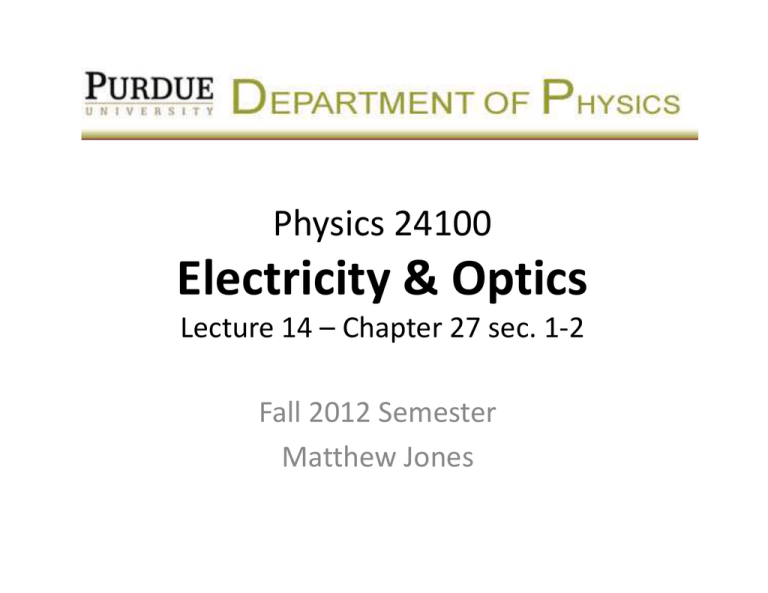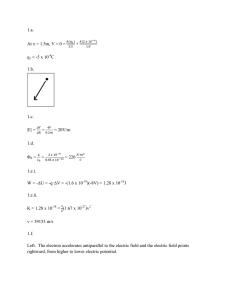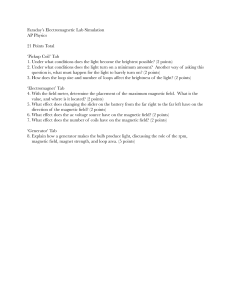Lecture 14
advertisement

Physics 24100 Electricity & Optics Lecture 14 – Chapter 27 sec. 1-2 Fall 2012 Semester Matthew Jones Question • A rectangular conductor carries current in a magnetic field as shown: • If the charge carriers are electrons, on which surface will a negative charge accumulate? (a) Top (b) Bottom (c) Left (d) Right Question = × • The force on the charge carriers will be perpendicular to both and so it must be either top or bottom. • Electrons move in the direction opposite the current. • The right-hand-rule tells you that × points down. • But is negative, so the negative charge accumulates on the top. The Hall Effect + • The Lorentz force is balanced by the electrostatic force: = = = • This tells us the direction and magnitude of the drift velocity of the charge carriers. The Hall Effect − • The Lorentz force is balanced by the electrostatic force: = = = • This tells us the direction and magnitude of the drift velocity of the charge carriers. Torque on a Current Loop • Consider a rectangular loop of wire carrying current in a magnetic field. • The orientation of the loop is given by the unit vector perpendicular to the plane of the loop. Torque on a Current Loop " ! = ̂ # • Magnitude of torque is = • Direction is perpendicular to = × = sin and : =− ̂ Torque on a Current Loop • In general, the torque does not depend on the shape, just the area. • With $ turns of wire in the loop, multiply by $. = $ & = × Potential Energy 1 • Work done by the magnetic field: '( = − ' • Loss of potential energy: ') = −'( = sin ' • Total change in potential energy: , ∆) = + ,- sin ' = − cos • Potential energy of a dipole in a magnetic field: )=− ∙ • Minimal potential energy when and are aligned. Magnetic Field • Electrostatics: – An electric field exerts a force on a charge – An charge produces an electric field 2 7̂ = 4456 7 • Magnetism: – A magnetic field exerts a force on a moving charge – A moving charge produces a magnetic field × 7̂ = 44 7 = 44 × 10:; < ∙ =/& 6 6 Magnetic Field • Moving charge: × 7̂ = 44 7 • Current flowing in a wire: 6 'ℓ × 7̂ ' = 44 7 (Biot-Savart Law) 6 'ℓ Observations 6 Question • What is the direction of the magnetic field at the center of the current loop: # ! A (a) @ " A (b) −@ (c) B̂ (d) Ĉ Question • What is the direction of the magnetic field at the center of the current loop: # A (a) @ ! A (b) −@ " (c) B̂ (d) Ĉ Current Carrying Wires • Use the principle of superposition: 'ℓ × 7̂ 'ℓ × 7 6 6 = + = + 44 7 44 7D • Very similar to the way we calculated : 1) 2) 3) 4) 5) 6) 7) Pick a coordinate system Label source and field points Pick variables to express their components Express 'ℓ, 7 and 7 using these variables Evaluate 'ℓ × 7 Write out the integral for each component Evaluate the integrals one way or another. New step! Example • Magnetic field around a long, straight wire: # Without loss of generality, pick the field point at F on the y-axis and the source point on the z-axis. !J ! " The magnetic field will be in the −Ĝ direction. We could also use a cylindrical coordinate system with unit vectors H, I, #̂ 2 = 44 F 6 Example • Magnetic field at the center of a current loop L 7̂ L 7̂ L #̂ = 6 2F 7̂ Example • Magnetic field on the axis of a current loop 7̂ L # #̂ F = 2 F +# 6 D/ Example • A solenoid is like a bunch of current loops with = $/N loops per unit length. 'OF ' = 2 F +# 6 where 'O = '#. • Inside a long solenoid, N ≫ F: 6 D/ Clicker Question • Treat a lightning bolt like a long, straight wire. • If the current in a lightning bolt is 100 kA, how would the magnetic field 1 km away compare with the Earth’s magnetic field (5 × 10:R <)? (a) Much less (b) Much greater (c) About the same ( 6 = 44 × 10:; < ∙ =/&)



